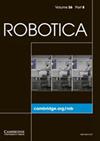模块化计算框架,用于对具有不同驱动类型的缆索驱动并联机器人进行动态分析,包括缆索的惯性、弹性和阻尼效应
IF 2.7
4区 计算机科学
Q3 ROBOTICS
引用次数: 0
摘要
对缆索驱动并联机器人(CDPR)进行动态模拟时,采用更贴近现实的缆索模型,能比采用理想模型更准确地预测移动平台的运动。因此,本研究为此提出了一个高效的模块化计算框架。主要重点是在长度保持不变的情况下,通过移动电缆的出口点来驱动 CDPR 时所需的开发。随后,该框架被扩展到采用电缆长度同时变化的情况。此外,在动态模型中还包括了三维运动中电缆的惯性、刚度和阻尼特性所产生的影响。为了最大限度地减少计算量,我们采用了先前研究中的高效递归前向动力学算法。最后,以空间 $4$ - $4$ CDPR 为例,通过将其应用于不同的应用场景,说明了所提框架的功效以及对这种包容性动态模型的需求。本文章由计算机程序翻译,如有差异,请以英文原文为准。
A modular computational framework for the dynamic analyses of cable-driven parallel robots with different types of actuation including the effects of inertia, elasticity and damping of cables
Dynamic simulations of the cable-driven parallel robots (CDPRs) with cable models closer to reality can predict the motions of moving platforms more accurately than those with idealisations. Hence, the present work proposes an efficient and modular computational framework for this purpose. The primary focus is on the developments required in the context of CDPRs actuated by moving the exit points of cables while the lengths are held constant. Subsequently, the framework is extended to those cases where simultaneous changes in the lengths of cables are employed. Also, the effects due to the inertia, stiffness and damping properties of the cables undergoing 3D motions are included in their dynamic models. The efficient recursive forward dynamics algorithms from the prior works are utilised to minimise the computational effort. Finally, the efficacy of the proposed framework and the need for such an inclusive dynamic model are illustrated by applying it to different application scenarios using the spatial $4$ - $4$ CDPR as an example.
求助全文
通过发布文献求助,成功后即可免费获取论文全文。
去求助
来源期刊

Robotica
工程技术-机器人学
CiteScore
4.50
自引率
22.20%
发文量
181
审稿时长
9.9 months
期刊介绍:
Robotica is a forum for the multidisciplinary subject of robotics and encourages developments, applications and research in this important field of automation and robotics with regard to industry, health, education and economic and social aspects of relevance. Coverage includes activities in hostile environments, applications in the service and manufacturing industries, biological robotics, dynamics and kinematics involved in robot design and uses, on-line robots, robot task planning, rehabilitation robotics, sensory perception, software in the widest sense, particularly in respect of programming languages and links with CAD/CAM systems, telerobotics and various other areas. In addition, interest is focused on various Artificial Intelligence topics of theoretical and practical interest.
 求助内容:
求助内容: 应助结果提醒方式:
应助结果提醒方式:


